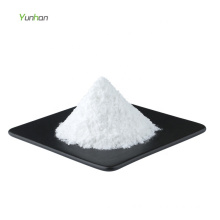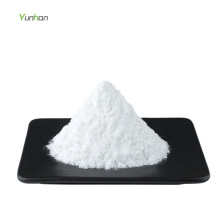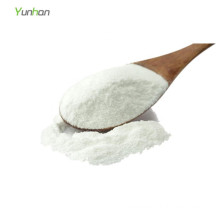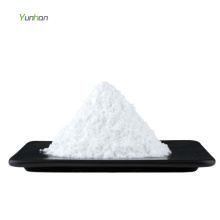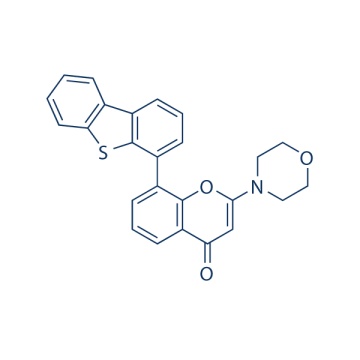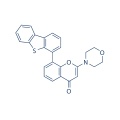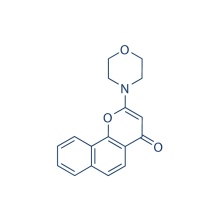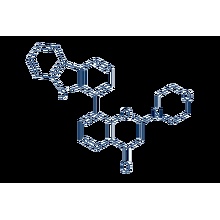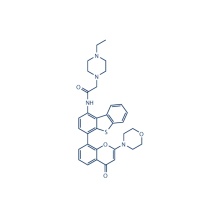NU7441 (KU-57788) 503468-95-9
Product Description
.cp_wz table {border-top: 1px solid #ccc;border-left:1px solid #ccc; } .cp_wz table td{border-right: 1px solid #ccc; border-bottom: 1px solid #ccc; padding: 5px 0px 0px 5px;} .cp_wz table th {border-right: 1px solid #ccc;border-bottom: 1px solid #ccc; padding: 5px 0px 0px 5px;}
Molecular Weight: 413.49 NU7441 (KU-57788) is a highly potent and selective DNA-PK Inhibitor with IC50 of 14 nM and also inhibits PI3K with IC50 of 5 μM.
NU7441 increases the persistence of γH2AX foci after ionizing
radiation–induced or etoposide-induced DNA Damage. NU7441 (0.5 μM or 1
μM) appreciably increases G2-M accumulation induced by ionizing
radiation, etoposide, and doxorubicin in both SW620 and LoVo cells. NU7441 causes persistence of doxorubicin- and ionising
radiation-induced DNA double-strand break and also slightly decreases
homologous recombination activity DNA-PK-proficient M059-Fus-1 and
DNA-PK-deficient M059 J human tumour cells.
NU7441
inhibits UV-induced RPA p34 hyperphosphorylation in a dose-dependent
manner both in cells lacking and cells expressing polymerase η. NU7441 increases levels of fludarabine-induced γH2AX foci and
correspondingly decreased fludarabine-induced cell death in chronic
lymphocytic leukemia cells. NU7441 also inhibits mitoxantrone-induced DNA-PKcs autophosphorylation and repair in chronic lymphocytic leukemia cells.
NU7441 intraperitoneally administrated at dose of 10 mg/kg maintains for
at least 4 hours shows nontoxic and increases etoposide-induced tumor
growth delay 2-fold in mice bearing SW620 xenografts.
Protocol(Only for Reference)
Cell Assay: [2]
Animal Study: [2]
Conversion of different model animals based on BSA (Value based on data from FDA Draft Guidelines)
For example, to modify the dose of resveratrol used for a mouse (22.4 mg/kg) to a dose based on the BSA for a rat, multiply 22.4 mg/kg by the Km factor for a mouse and then divide by the Km factor for a rat. This calculation results in a rat equivalent dose for resveratrol of 11.2 mg/kg.
Chemical Information
Molarity Calculator
Dilution Calculator
Molecular Weight Calculator
Contact us if you need more details on NU7441 503468-95-9. We are ready to answer your questions on packaging, logistics, certification or any other aspects about KU-57788 503468-95-9、503468-95-9. If these products fail to match your need, please contact us and we would like to provide relevant information.
Molecular Weight: 413.49 NU7441 (KU-57788) is a highly potent and selective DNA-PK Inhibitor with IC50 of 14 nM and also inhibits PI3K with IC50 of 5 μM.
NU7441 increases the persistence of γH2AX foci after ionizing
radiation–induced or etoposide-induced DNA Damage. NU7441 (0.5 μM or 1
μM) appreciably increases G2-M accumulation induced by ionizing
radiation, etoposide, and doxorubicin in both SW620 and LoVo cells. NU7441 causes persistence of doxorubicin- and ionising
radiation-induced DNA double-strand break and also slightly decreases
homologous recombination activity DNA-PK-proficient M059-Fus-1 and
DNA-PK-deficient M059 J human tumour cells.
NU7441
inhibits UV-induced RPA p34 hyperphosphorylation in a dose-dependent
manner both in cells lacking and cells expressing polymerase η. NU7441 increases levels of fludarabine-induced γH2AX foci and
correspondingly decreased fludarabine-induced cell death in chronic
lymphocytic leukemia cells. NU7441 also inhibits mitoxantrone-induced DNA-PKcs autophosphorylation and repair in chronic lymphocytic leukemia cells.
NU7441 intraperitoneally administrated at dose of 10 mg/kg maintains for
at least 4 hours shows nontoxic and increases etoposide-induced tumor
growth delay 2-fold in mice bearing SW620 xenografts.
Protocol(Only for Reference)
Cell Assay: [2]
| Cell lines | SW620, LoVo, V3-YAC and V3 cells |
|---|---|
| Concentrations | 0.5 μM or 1 μM |
| Incubation Time | 17 hours |
| Method | The effect of NU7441 on cellular survival following exposure to etoposide, doxorubicin, and ionizing radiation is measured in SW620, LoVo, V3, and V3-YAC cells by clonogenic assays. Briefly, growing cells in six-well plates or 6-cm dishes are exposed to etoposide or doxorubicin with or without NU7441 (0.5 or 1.0 μM) for 16 hours. For radiosensitization studies, NU7441 is added to the cells 1 hour before irradiation. V3 and V3-YAC cells are exposed to γ-irradiation (3.1 Gy/min 137Cesium). SW620 and LoVo are exposed to X-irradiation (2.9 Gy/min at 230 kV, 10 mA) due to the equipment available. After irradiation, the cells are incubated with or without NU7441 for a further 16 hours. Cells are then harvested by trypsinization, counted, and seeded into 10-cm diameter Petri dishes at densities varying from 100 to 105 per dish in drug-free medium for colony formation. Colonies are stained with crystal violet after 10 to 14 days and counted with an automated colony counter. The survival reduction factor (SRF) is calculated as the surviving fraction of cells in the absence of NU7441 divided by the surviving fraction of cells in the presence of NU7441 for any given dose or concentration of cytotoxic agent. The dose modification ratio (DMR90) is calculated as the concentration/dose of cytotoxic agent required to kill 90% of the cells in the absence of NU7441 divided by the concentration/dose of cytotoxic agent required to kill 90% of the cells in the presence of NU7441. |
Animal Study: [2]
| Animal Models | Female rude mice bearing SW620 xenografts |
|---|---|
| Formulation | Sterile 0.9% sodium chloride solution |
| Dosages | 10 mg/kg |
| Administration | Intraperitoneally administrated |
Conversion of different model animals based on BSA (Value based on data from FDA Draft Guidelines)
| Species | Baboon | Dog | Monkey | Rabbit | Guinea pig | Rat | Hamster | Mouse |
| Weight (kg) | 12 | 10 | 3 | 1.8 | 0.4 | 0.15 | 0.08 | 0.02 |
| Body Surface Area (m2) | 0.6 | 0.5 | 0.24 | 0.15 | 0.05 | 0.025 | 0.02 | 0.007 |
| Km factor | 20 | 20 | 12 | 12 | 8 | 6 | 5 | 3 |
| Animal A (mg/kg) = Animal B (mg/kg) multiplied by | Animal B Km |
| Animal A Km |
For example, to modify the dose of resveratrol used for a mouse (22.4 mg/kg) to a dose based on the BSA for a rat, multiply 22.4 mg/kg by the Km factor for a mouse and then divide by the Km factor for a rat. This calculation results in a rat equivalent dose for resveratrol of 11.2 mg/kg.
| Rat dose (mg/kg) = mouse dose (22.4 mg/kg) × | mouse Km(3) | = 11.2 mg/kg |
| rat Km(6) |
Chemical Information
| Molecular Weight (MW) | 413.49 |
|---|---|
| Formula | C25H19NO3S |
| CAS No. | 503468-95-9 |
| Storage | 3 years -20℃Powder |
|---|---|
| 6 months-80℃in solvent (DMSO, water, etc.) | |
| Synonyms | |
| Solubility (25°C) * | In vitro | DMSO | 3 mg/mL (7.25 mM) |
|---|---|---|---|
| Water | <1 mg/mL ( | ||
| Ethanol | <1 mg/mL ( | ||
| * <1 mg/ml means slightly soluble or insoluble. * Please note that Selleck tests the solubility of all compounds in-house, and the actual solubility may differ slightly from published values. This is normal and is due to slight batch-to-batch variations. | |||
| Chemical Name | 4H-1-Benzopyran-4-one, 8-(4-dibenzothienyl)-2-(4-morpholinyl)- |
|---|
Molarity Calculator
Dilution Calculator
Molecular Weight Calculator
Contact us if you need more details on NU7441 503468-95-9. We are ready to answer your questions on packaging, logistics, certification or any other aspects about KU-57788 503468-95-9、503468-95-9. If these products fail to match your need, please contact us and we would like to provide relevant information.
Product Categories : PI3K/Akt/mTOR > DNA-PK Inhibitor
Other Products
Hot Products
Astragaloside AChlortetracycline HCl 64-72-2Paclitaxel 33069-62-4Dexamethasone Acetate 1177-87-3Dinaciclib (SCH727965) 779353-01-4CHIR-124 405168-58-3Ro3280 1062243-51-9TAME 901-47-3CCG-1423 285986-88-110058-F4 403811-55-2Dabigatran (BIBR 953) 211914-51-1H 89 2HCl 130964-39-5T0901317 293754-55-9Aprepitant 170729-80-3Turofexorate Isopropyl (XL335) 629664-81-9BMS-378806 357263-13-9

